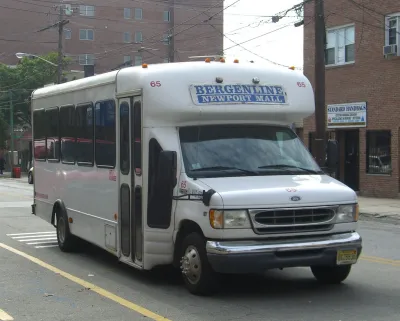A semi-formal transportation system has served New Yorkers for half a century, but complex regulations prevent most drivers from operating legally.

An unofficial transportation system has been a lifeline for thousands of New Yorkers, but increasing operating costs and regulatory hurdles put the network of ‘dollar vans’ in jeopardy.
Andrés Pacheco-Girón interviews riders and operators for a piece for Feet in 2 Worlds, explaining that the system grew out of largely immigrant communities’ experience with informal transit systems in other countries. “Following the New Yorker tradition of naming things after their price — like dollar pizza slices, or quarter waters — dollar vans became part of the fabric of the city.”
The commuter vans started operating in the 1970s and have proliferated since. They now charge varying rates based on routes and locations, and offer efficiency often unmatched by existing MTA lines.
But they operate in a legal grey area; hailing a dollar van on the street is technically illegal, and “Drivers also face challenges meeting the current requirements set by the city Taxi Limousine Commission, or TLC. Requirements include regular TLC inspections and insurance costs that can go as high as 50,000 dollars.” As of October 2024, there were 35 licensed commuter vans in the city, but many more can be seen operating on city streets.
Advocates like the Commuter Van Association of New York want to see the city reduce financial and regulatory burdens. Meanwhile, a commuter van startup is trying to modernize the industry with electric vehicles, which could lower operating costs.
FULL STORY: How NYC Dollar Vans Are Adapting for the Future

Montreal Mall to Become 6,000 Housing Units
Place Versailles will be transformed into a mixed-use complex over the next 25 years.

Planetizen Federal Action Tracker
A weekly monitor of how Trump’s orders and actions are impacting planners and planning in America.

DARTSpace Platform Streamlines Dallas TOD Application Process
The Dallas transit agency hopes a shorter permitting timeline will boost transit-oriented development around rail stations.

Interactive Map Reveals America's “Shade Deserts”
Launched by UCLA and American Forests to combat heat-related deaths, the tool maps the shade infrastructure for over 360 U.S. cities.

Bicycles and Books — In Sacramento, Libraries Now Offer Both
Adult library card holders can check out e-bikes and e-trikes for up to one week.

Colorado Landfills Emit as Much Pollution as 1M Cars
Landfills are the third-largest source of methane pollution in Colorado, after agriculture and fossil fuel extraction.
Urban Design for Planners 1: Software Tools
This six-course series explores essential urban design concepts using open source software and equips planners with the tools they need to participate fully in the urban design process.
Planning for Universal Design
Learn the tools for implementing Universal Design in planning regulations.
City of Mt Shasta
City of Camden Redevelopment Agency
City of Astoria
Transportation Research & Education Center (TREC) at Portland State University
City of Camden Redevelopment Agency
Municipality of Princeton (NJ)
Regional Transportation Commission of Southern Nevada





























